Do you want to add a bonsai indoor tree for modern homes in the USA? Low-maintenance bonsai indoor tree for modern home and small spaces, and easy indoor dwarf plants that fit your state-of-the-art decor.
For modern homes in the United States, several types of bonsai trees thrive indoors. Ficus (Ficus Benjamina, Ficus Ginseng), Chinese Elm (Ulmus parvifolia), and Jade (Portulacaria afra) bonsai are popular choices due to their resilience and visual appeal.
A tiny tree with a big impact on your home vibe, it brings a touch of green and peacefulness to your stylish home decor. Hawaiian Umbrella and Fukien Tea bonsai are also excellent options for indoor environments.
Something small, stylish, and alive but not messy or hard to care for? Then an indoor bonsai tree might be just what you’re looking for beginner bonsai lovers.
Tiny trees like the Ficus Microcarpa, Snake plant (Sansevieria Trifasciata), or Dwarf Jade plant grow well inside and don’t need much space. They fit right in with a minimalist design and bring calm to your room.
These bonsai trees thrive in bright, soft light from a window and require only minimal watering and light pruning to stay healthy. Some even grow tiny flowers or have shiny leaves that make them look like traditional living art.
Each bonsai has roots in the old Japanese Bonsai is deeply rooted in Japanese Zen Buddhist philosophy and the concept of wabi-sabi. Traditional Chinese bonsai, known as Penjing, is the art of creating miniature, lifelike trees in containers, reflecting nature’s beauty and balance.
Originating in China over 1300 years ago, it was initially practiced by the elite and later adopted in Japan. But now they bring joy into modern homes across the USA. In just a few weeks, you’ll have your tiny tree that grows with you.
And the best part? You don’t need to be an expert. You can start with a healthy tree from trusted sellers like Bonsai Boy or Eastern Leaf.
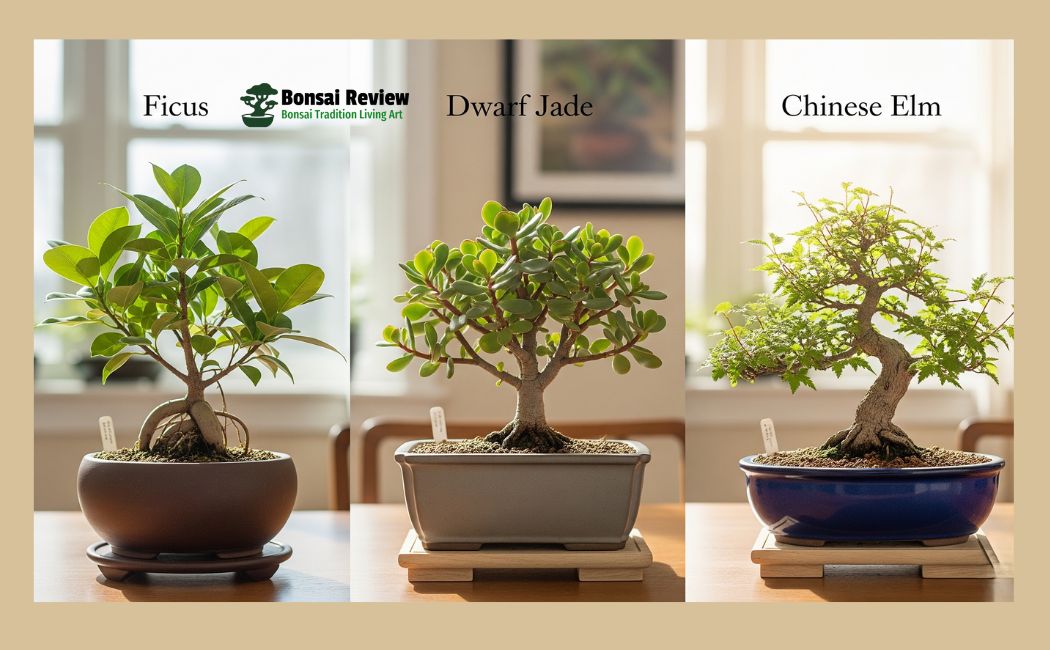
What Makes a Bonsai Tree Indoor-Friendly in the USA?
Not every bonsai can live inside your home. Some trees need full sun or cold winters to grow strong, but indoor bonsai trees are different. They’re chosen because they can handle the light, temperature, and air found inside most U.S. homes. Here’s what to look for when picking a bonsai for your living room, kitchen, or office:
1. Light Needs: Most of the bonsai indoor tree for modern homes in the US, like the Snake plant, Ficus microcarpa, or Hawaiian Umbrella, love bright but soft light. A window facing east or south is perfect. Try not to place your tree in full, direct sunlight all day. If your room is dark, a grow light can help.
2. Temperature: Indoor bonsai trees do well when your home stays around 60–75°F (15–24°C). Don’t place them near heaters, AC vents, or cold drafts. Bonsai indoor tree for modern homes can stress the tiny plants.
3. Humidity: Bonsai indoor tree for modern homes in the USA often have dry indoor air, especially in winter. Bonsai like the Schefflera or Fukien Tea enjoy more moisture. You can use a humidity tray or spray the leaves gently to help.
4. Easy Roots: Indoor bonsai are usually tropical or subtropical trees. That means they’re not too picky about changing seasons. These trees are easier to keep happy all year round in places like New York, California, or even Texas.
Tip Bonsai Indoor Tree for Modern Homes: Look for bonsai listed as indoor-safe by trusted sellers like Eastern Leaf or Bonsai Boy. They’ll guide you to species that fit your room and routine.
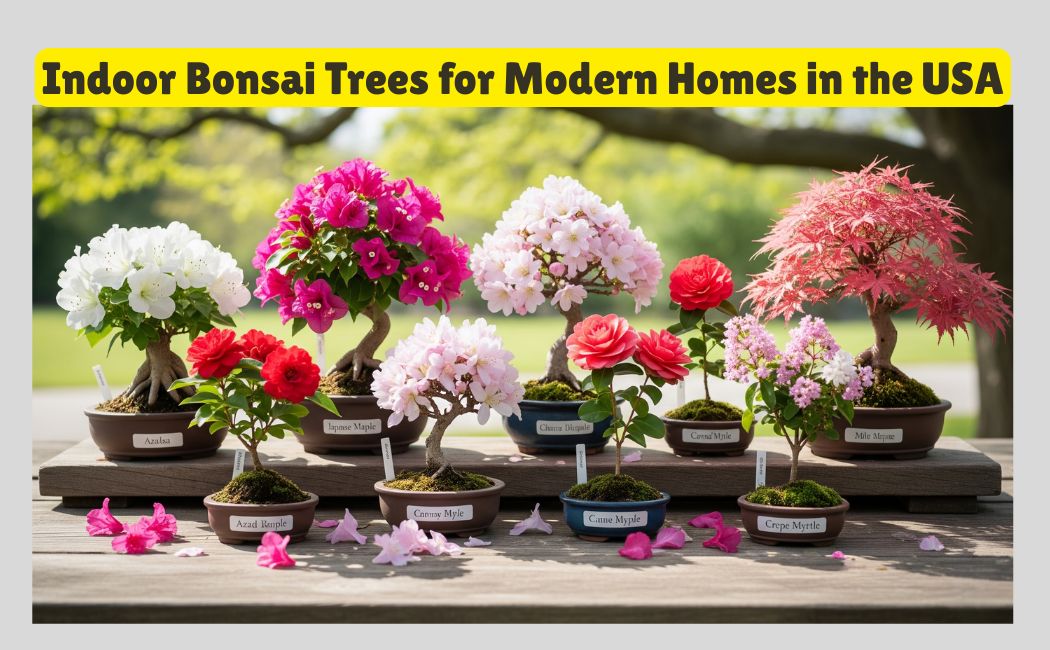
Style & Care Tips: 5 Top Bonsai Indoor Tree for Modern Homes in the USA.
Choosing the right bonsai for your modern home means finding a tree that’s not just easy to care for, but also looks beautiful in your space. These trees grow well indoors, match clean and stylish decor, and don’t mind life inside your living room or office. Below is a simple guide to help you pick the one that fits your space best:
| Bonsai Tree | Why It’s Great Indoors | Light Needs | Water Needs | Style Fit |
| Ficus Microcarpa | Tough and glossy; good for beginners | Bright, indirect light | Once a week | Minimalist & bold spaces |
| Chinese Elm | Hardy and classic look; adapts well indoors/outdoors | Medium light | Moderate | Office or living room |
| Hawaiian Umbrella | Thick canopy with glossy leaves; loves humidity | Low to medium light | Low | Entryways or hall corners |
| Dwarf Jade (Portulacaria afra) | Succulent leaves, low care, modern leaf shape | Bright light | Very low | Small shelves or desks |
| Fukien Tea (Carmona) | Tiny white flowers and shiny leaves; an indoor specialist | Medium to bright light | Moderate | Zen nooks or cozy corners |
These bonsai indoor tree for modern homes in the USA are great for people who live in apartments, houses with big windows, or even shared workspaces. They stay compact, don’t need much water, and still bring big charm into any room.
Quick Tip: If you’re just starting out, go for the Ficus or Dwarf Jade plant. They’re more forgiving and bounce back even if you make a mistake.
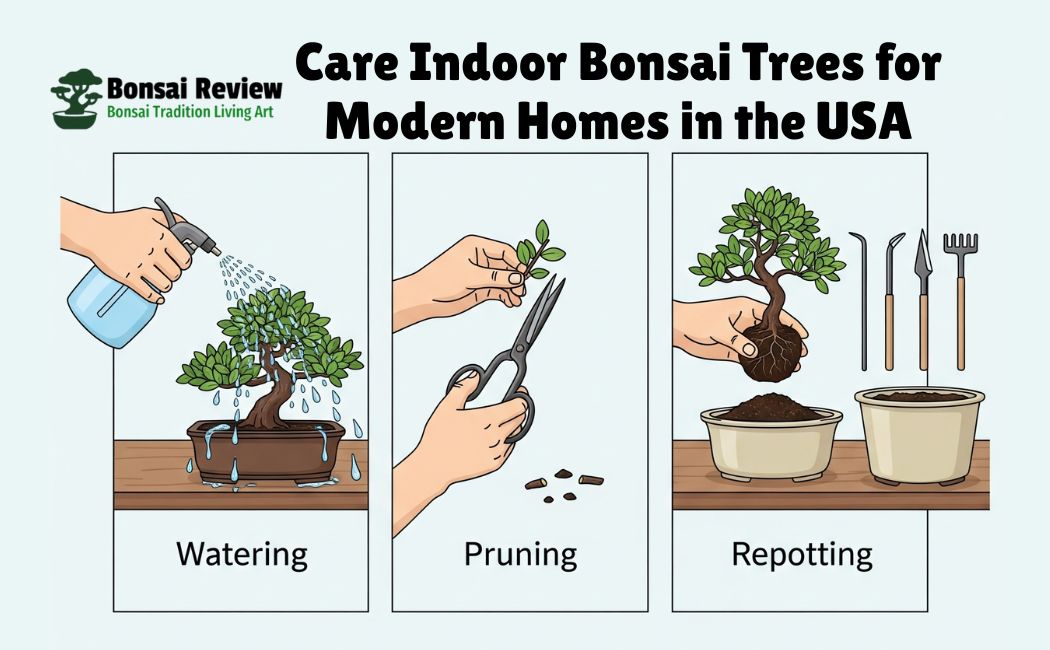
How to Choose Bonsai Styles That Fit Modern Decor?
A bonsai isn’t just a plant. It’s a living sculpture. And when you place it in a modern home, it should match your room’s clean lines, soft colors, and calm energy. That’s why choosing the right bonsai style and pot is just as important as choosing the tree itself.
Common Bonsai Styles That Suit Modern Homes
| Style Name | Look | Best For |
| Formal Upright | Straight trunk, balanced branches | Minimalist and symmetrical spaces |
| Informal Upright | Gently curved trunk, relaxed form | Living rooms or calm nooks |
| Cascade (Kengai) | Trunk falls below the pot, dramatic | Table centerpieces, side stands |
| Semi-Cascade | Slightly flowing shape | Shelf edges or wall corners |
| Banyan (Root-over-rock) | Thick roots, tropical feel | Artistic or Zen-style spaces |
Pot and Decor Tips: Bonsai Indoor Tree For Modern Home in the U.S.
- Choose ceramic pots in white, gray, or matte black, and they look clean and modern.
- Go for round or rectangular pots to match your home’s shape patterns.
- Use wood or metal stands to lift the tree and give it a gallery-style feel.
- Keep the space around the bonsai clutter-free so it stands out.
Style Idea: A Ficus bonsai in a shallow white pot on a wooden shelf brings a peaceful, Japanese-style vibe into a modern kitchen or study.
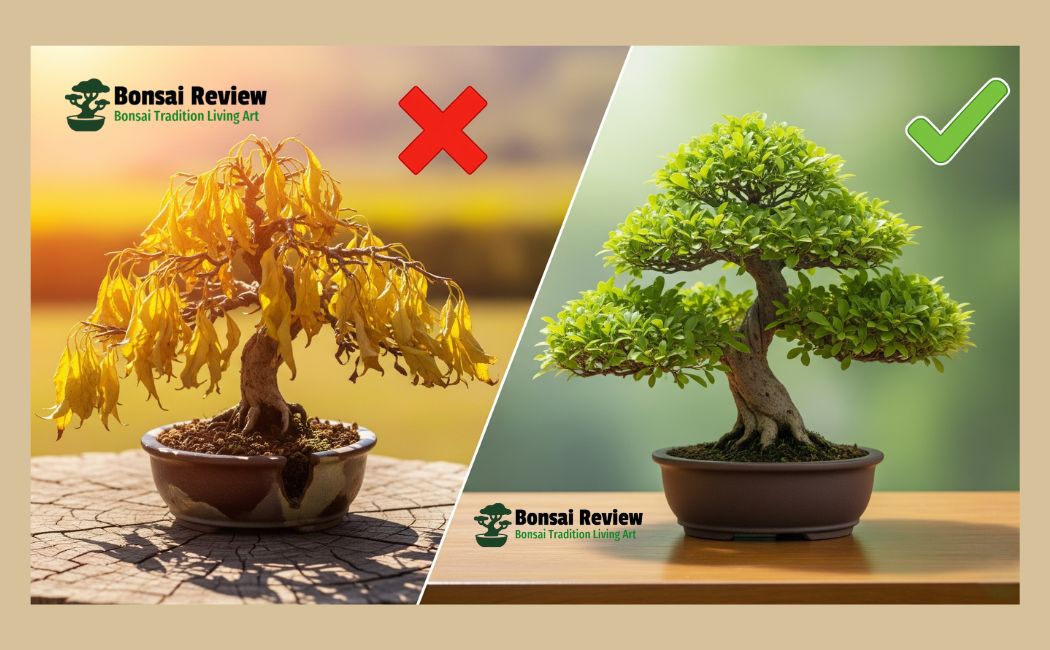
Bonsai Care Tips for U.S. Indoor Environments
Now that you’ve picked the perfect bonsai for your home, it’s time to learn how to take care of it. The good news? Indoor bonsai trees like the Snake plant (Sansevieria trifasciata), Ficus, Dwarf Jade, or Chinese Elm are easier than you think. You just need to follow a few simple steps to keep them happy.
Light: Bonsai Indoor Tree for Modern House in the U.S.
- Place your bonsai near a bright window, but not in harsh direct sun.
- East or south-facing windows work best.
- If your home is dark, use a grow light for extra help.
Watering: Best Bonsai Indoor Tree for Modern Houseplant in the United States.
- Don’t water on a schedule, and check the soil with your finger.
- When the top feels dry, water deeply until it runs out of the drainage hole.
- Never let it sit in water or go bone dry.
Pruning: Beginner-Friendly Indoor Bonsai Trees for Contemporary Living.
- Lightly trim new shoots to keep the shape.
- Use bonsai scissors to snip cleanly just above a leaf node.
- Don’t cut too much at once for a little at a time is best.
Fertilizing: Beginners Bonsai Lovers Indoor Best Picks for U.S. Households.
- Use a balanced liquid bonsai fertilizer (10-10-10 or similar).
- Feed your bonsai every 2–4 weeks during spring and summer.
- In winter, feed only once a month or not at all.
Repotting: Bonsai Indoor Plants
- Every 1–2 years, your bonsai needs fresh soil and root trimming.
- Spring is the best time for this.
- Use a proper bonsai soil mix with good drainage.
Bonus Tip: If your air is dry, like during U.S. winters, place your bonsai on a humidity tray or mist the leaves gently once a day.
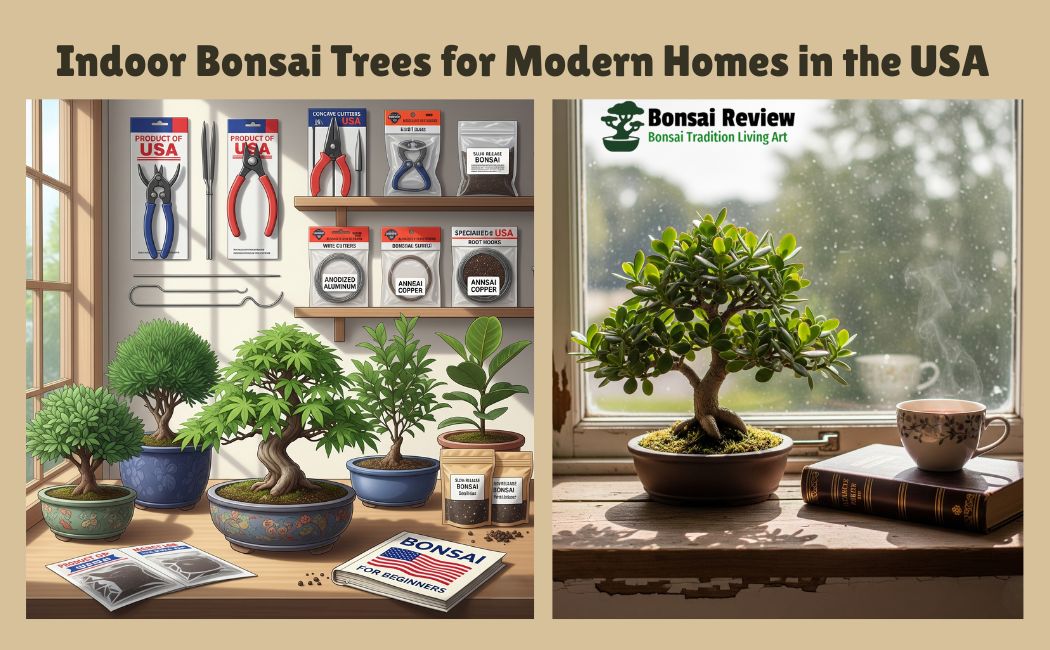
Where to Buy a Healthy Bonsai Indoor Tree for modern use in the USA?
Formatted in a clean, easy-to-follow comparison table with entity-rich info:
| Seller | What They Offer | Best For | Bonsai Types Available |
| Bonsai Boy (New York) | Trusted U.S. bonsai nursery with 30+ years of experience | Beginners & collectors | Ficus, Jade, Chinese Elm, Schefflera |
| Eastern Leaf | Stylish indoor bonsai trees + ceramic pots, tools, and beginner kits | Modern home setups | Ficus, Fukien Tea, Umbrella Tree |
| Brussels Bonsai | One of the largest bonsai growers in the U.S. offers rare species | Serious hobbyists | Dwarf Jade, Carmona, Chinese Elm, Juniper* |
| Herons Bonsai (UK) | Ships to the U.S.; known for high-quality specimens & care tips | High-end buyers | Chinese Elm, Serissa, Bonsai styles for décor |
| Etsy | Handmade bonsai trees and pots from small sellers | Budget-friendly gift ideas | Mixed Ficus, Jade, Umbrella Tree, Decorative |
Note: Juniper is not ideal for indoor care. Use only in outdoor bonsai.
Buying Tips: Bonsai Indoor Tree for Modern Homes in the United States.
- Always choose “indoor bonsai” options.
- Look for a thick trunk, healthy leaves, and moist, not soggy soil.
- Avoid trees that look weak, dry, or recently shipped with bare roots.

Common Mistakes to Avoid: Perfect Indoor Bonsai Tree for U.S. Beginners.
Even though indoor bonsai trees are easier to care for than outdoor ones, many beginners make small mistakes that can harm the tree. Don’t worry if you know what to watch out for, your bonsai will grow strong and healthy.
1. Overwatering or Underwatering
One of the biggest bonsai mistakes is with water. Some people water too often, and others forget to water for days. Your bonsai needs balance. If the soil stays too wet, the roots can rot. But if it gets too dry, the tree will start to drop leaves. Always check the top inch of soil with your finger. Water only when it feels dry, and make sure the pot has drainage holes.
2. Too Much or Too Little Light
Bonsai like the Ficus microcarpa need bright, indirect light. But putting the tree in a dark corner or right under the hot sun can hurt it. Place your bonsai near a window that gets morning or soft afternoon sun. If natural light is low in your home, a small LED grow light can help.
3. Placing Near Air Vents or Heaters
Bonsai trees don’t like sudden temperature changes. If you place your tree near a heater, air conditioner, or drafty window, it may get stressed and lose leaves. Keep your bonsai in a stable spot with an even room temperature between 60°F to 75°F is ideal.
4. Choosing the Wrong Type of Bonsai
Some bonsai indoor trees for modern homes in the US, like Juniper, are meant to be grown outdoors. Many beginners buy them thinking they’re indoor-safe, but they slowly weaken indoors. For your home, stick with true indoor bonsai species like Snake plant for air purifying, Ficus, Dwarf Jade, Chinese Elm, or Hawaiian Umbrella Tree.
5. Pruning Too Much, Too Soon
Trimming is part of bonsai care essential tool kits, but don’t go wild with the scissors! For the beginner bonsai lover, start by doing light pruning to shape the tree. Cutting too many leaves or branches at once can cause the plant to be shocked. Take it slow, and only trim new shoots growing out of shape.
Conclusion: Which Dwarf Plants Grow Best in the U.S.?
A Tiny Tree, A Big Feeling in Your Room! Bonsai indoor tree for modern homes. Bringing a houseplant and an indoor bonsai tree is more than just adding greenery. It’s like adding a quiet, living piece of art to your space.
A NASA study on air-purifying plants identified that in your modern home, other top contenders for air purification include Peace Lilies, Spider Plants, and Aloe Vera. A bonsai like the Ficus, Chinese Elm, or Dwarf Jade fits perfectly. It doesn’t need a big garden. It just needs a little light, water, and care.
You don’t have to be a plant expert. With the right miniature tree and a few simple steps, you’ll enjoy peace, beauty, and a deeper connection to nature, right from your shelf or windowsill. And as your bonsai grows, it becomes part of your story too.
So go ahead. Pick a bonsai that suits your style, place it where it can shine, and let it remind you each day to slow down and breathe.
Best informative article: Which Are the Best Bonsai Plants for Indoor Air Purification?
FAQs: Bonsai Indoor Tree for Modern Homes in the USA.
1. What is the Easiest Indoor Bonsai Tree for Beginners?
The Ficus microcarpa is one of the easiest bonsai trees to care for indoors. It’s strong, forgiving, and grows well even in lower humidity. Dwarf Jade plant is another great choice because it stores water in its leaves and needs little care.
2. Can I keep a bonsai tree in my bedroom?
Yes! As long as the room gets natural light, like near a window, a bonsai can live happily in your bedroom. Just make sure it’s not too close to heaters or air conditioners.
3. Do bonsai trees need sunlight indoors?
Yes, but not direct sun all day. Bonsai trees like bright, indirect light. A spot near an east- or south-facing window is ideal. If there’s not enough light, use a small LED grow light.
4. How often should I water my indoor bonsai tree?
Water when the top inch of soil feels dry. Don’t follow a strict schedule. Some trees, like Fukien Tea, may need water every few days, while others, like Dwarf Jade, need less.
5. Which bonsai tree is best for a modern apartment?
The Hawaiian Umbrella Tree and Ficus are perfect for apartments. They look sleek, grow in small pots, and match minimalist home decor. They also handle indoor air better than most.
6. What plant removes 78% of airborne mold?
English Ivy is exceptional at purifying air, removing 78% of airborne mold in 12 hours. Its dense foliage traps moisture and absorbs mold spores and other airborne toxins, making it an ideal choice for improving indoor air quality and alleviating allergy symptoms.
7. Where is the best place to put a bonsai tree in your house?
Indoor bonsai trees thrive best near a south-facing window. Bonsai Indoor Tree for Modern Homes needs plenty of natural sunlight and air circulation.